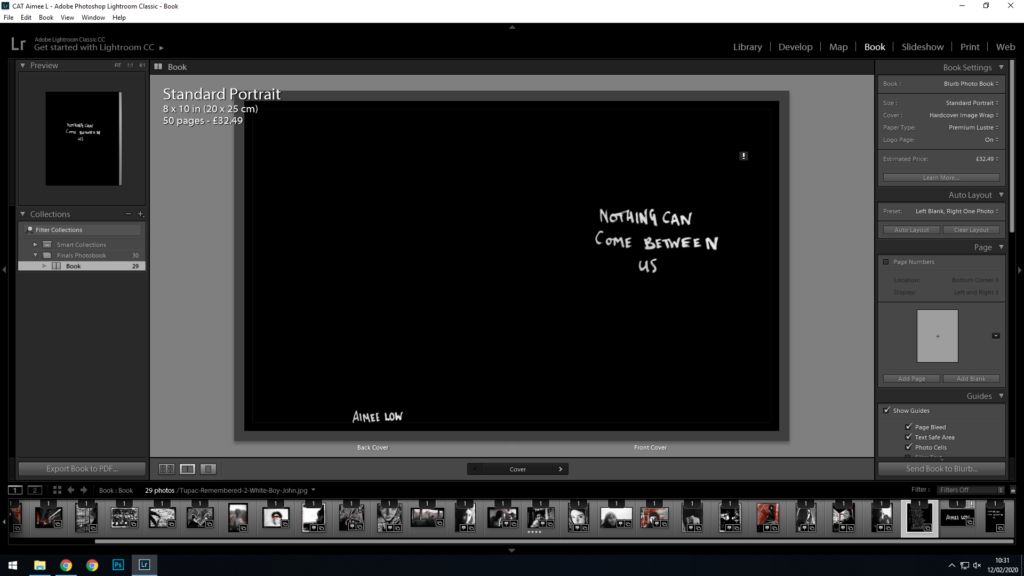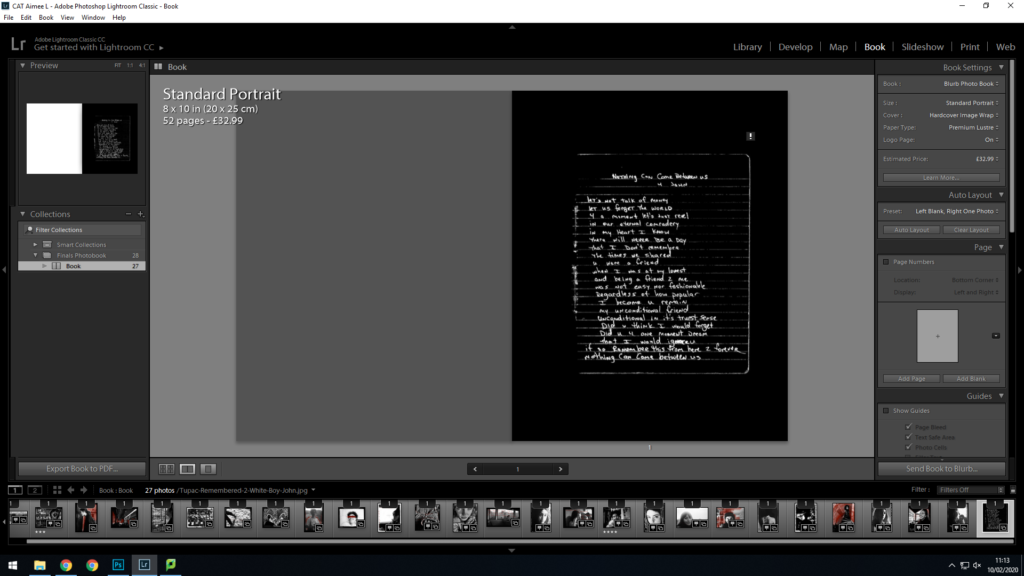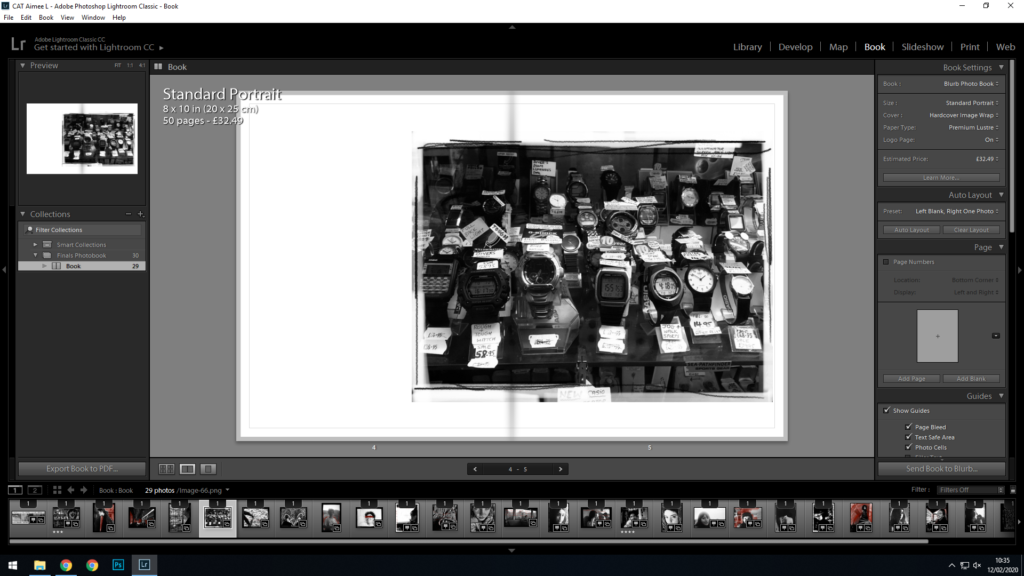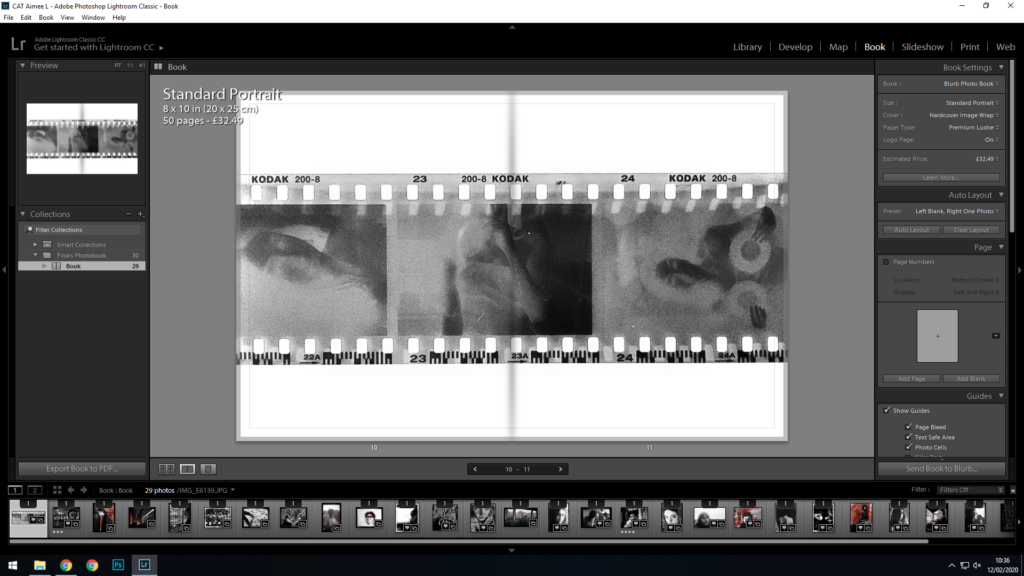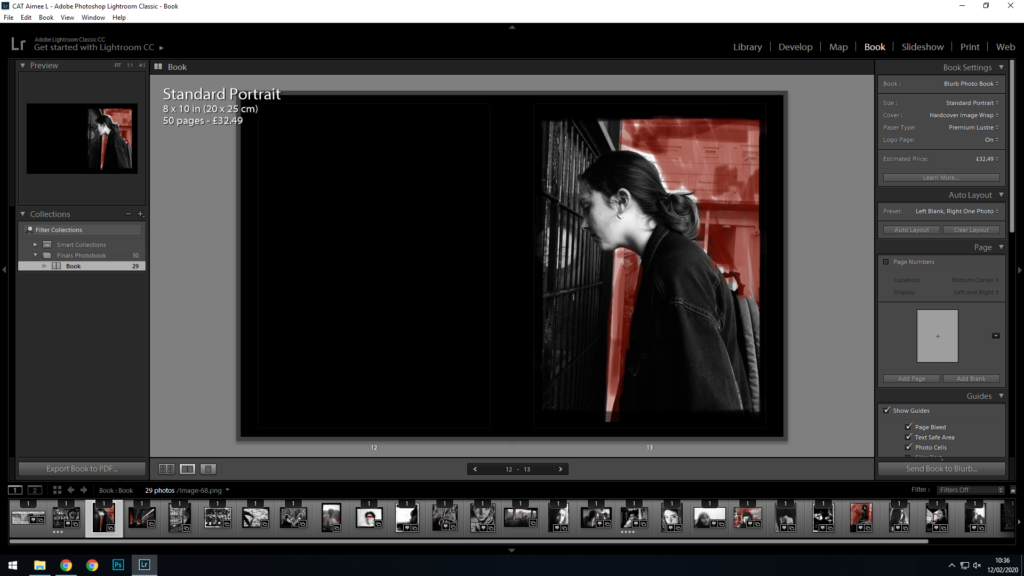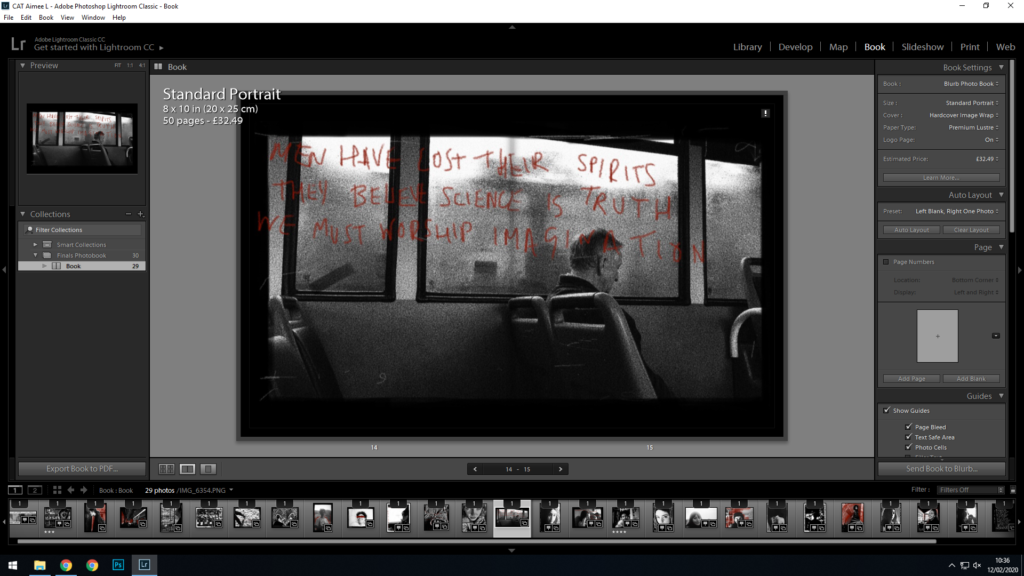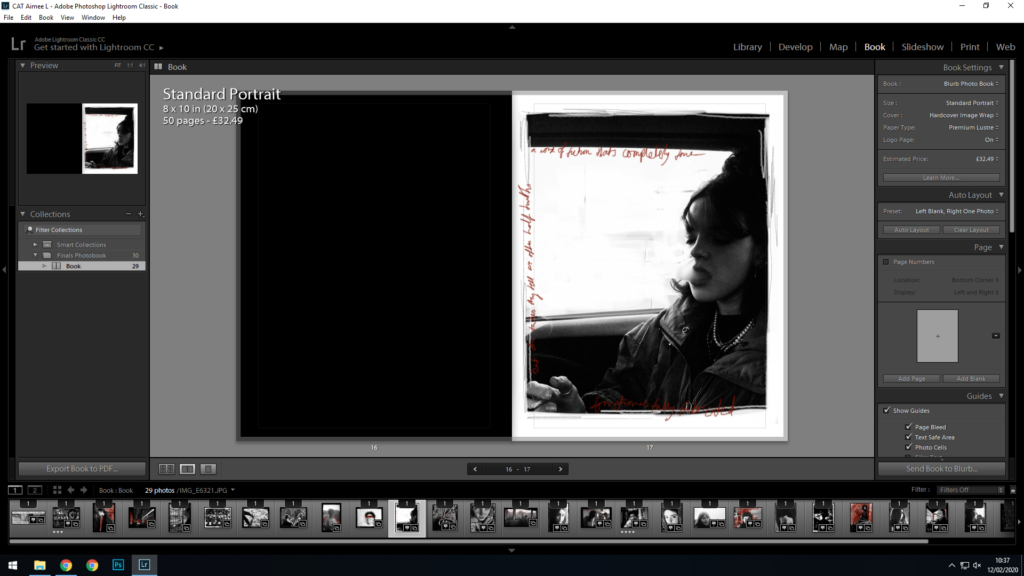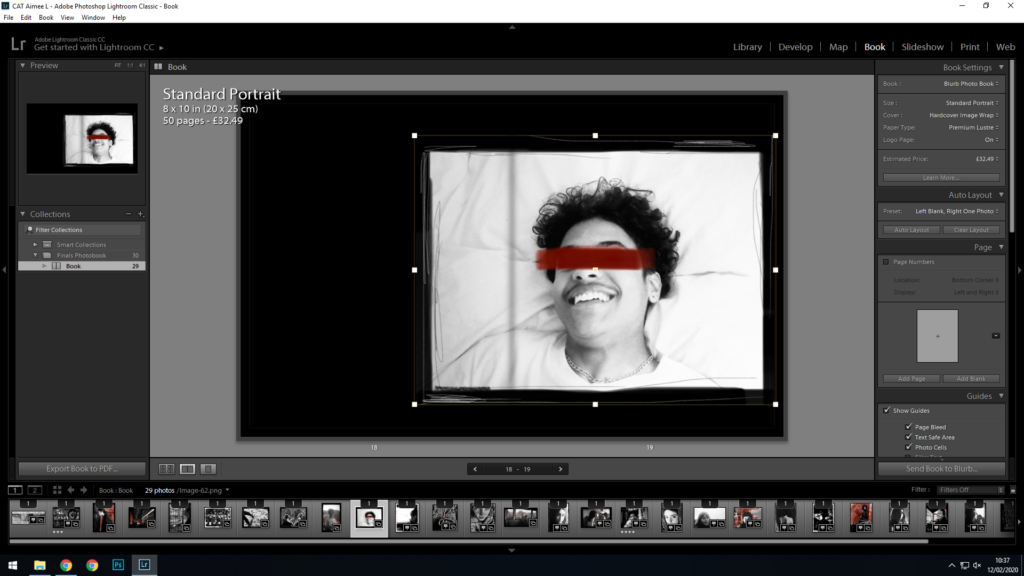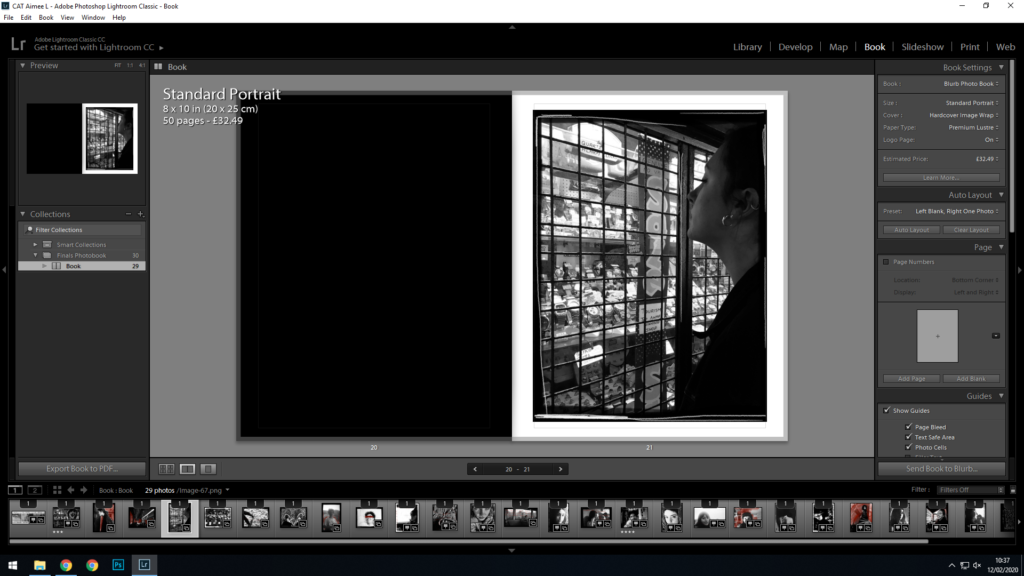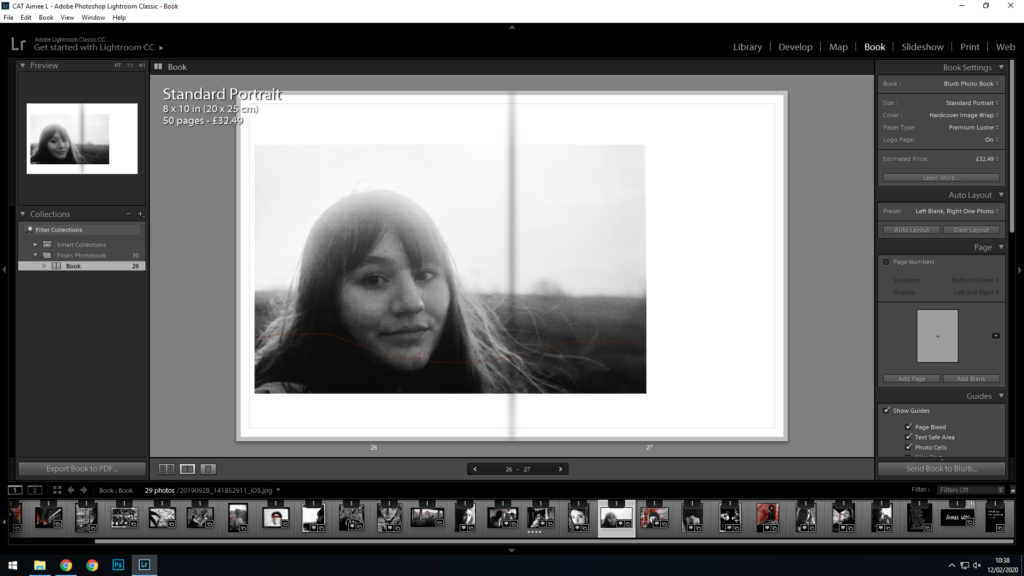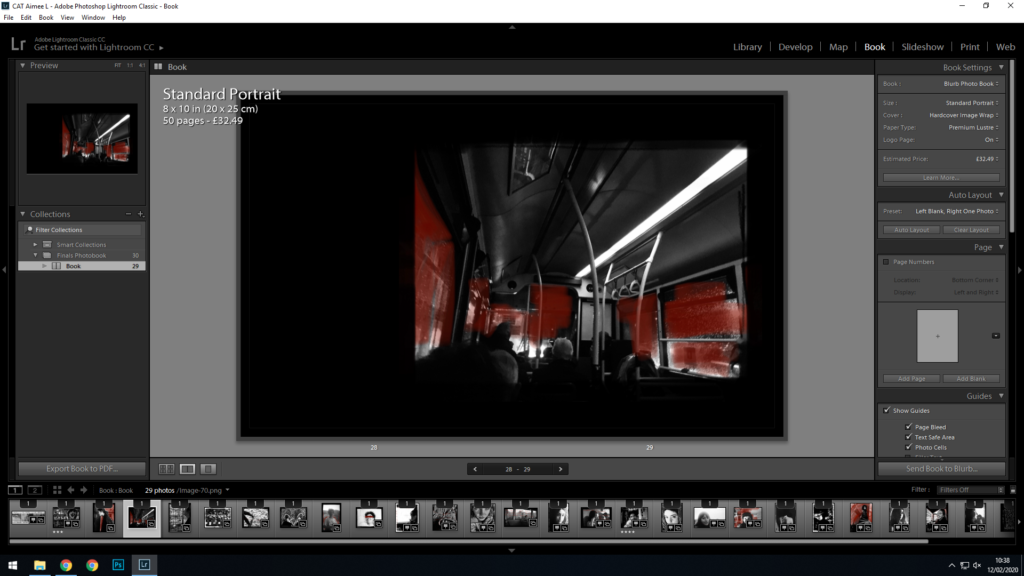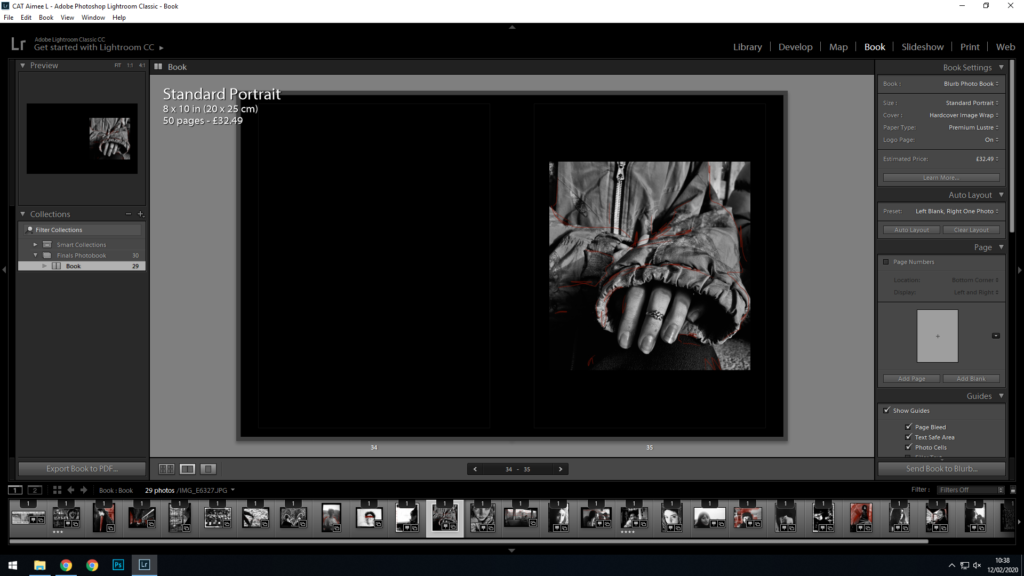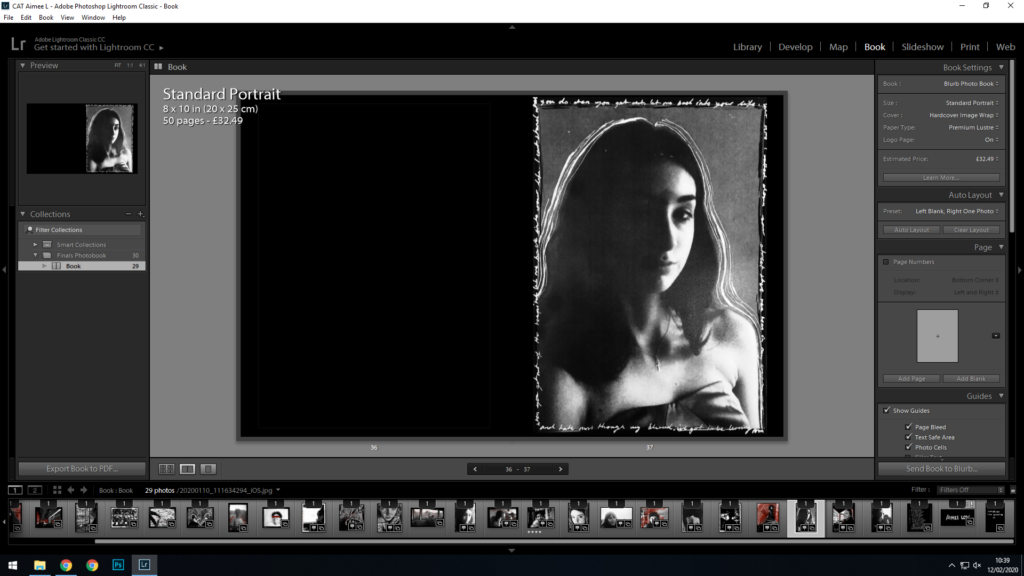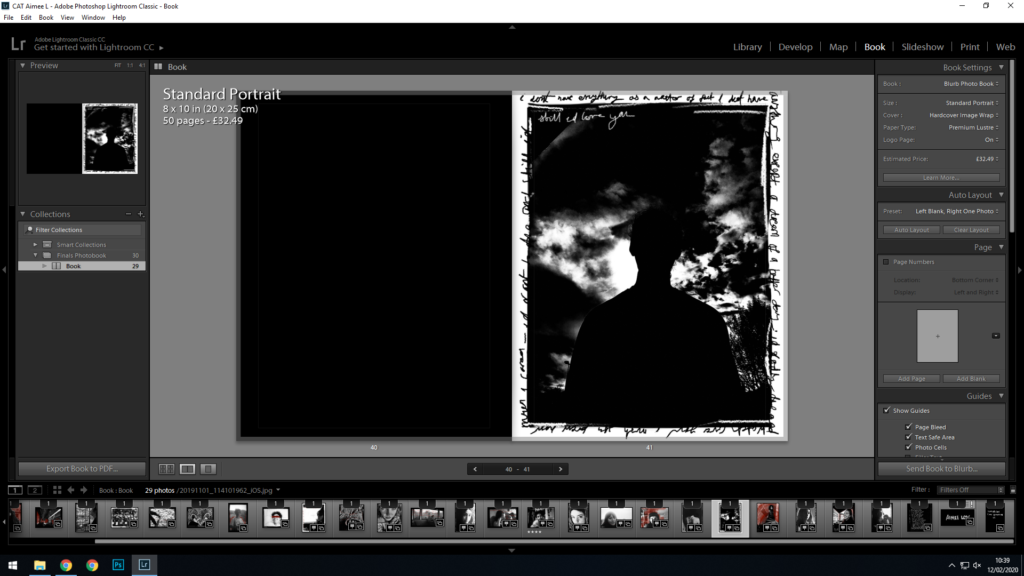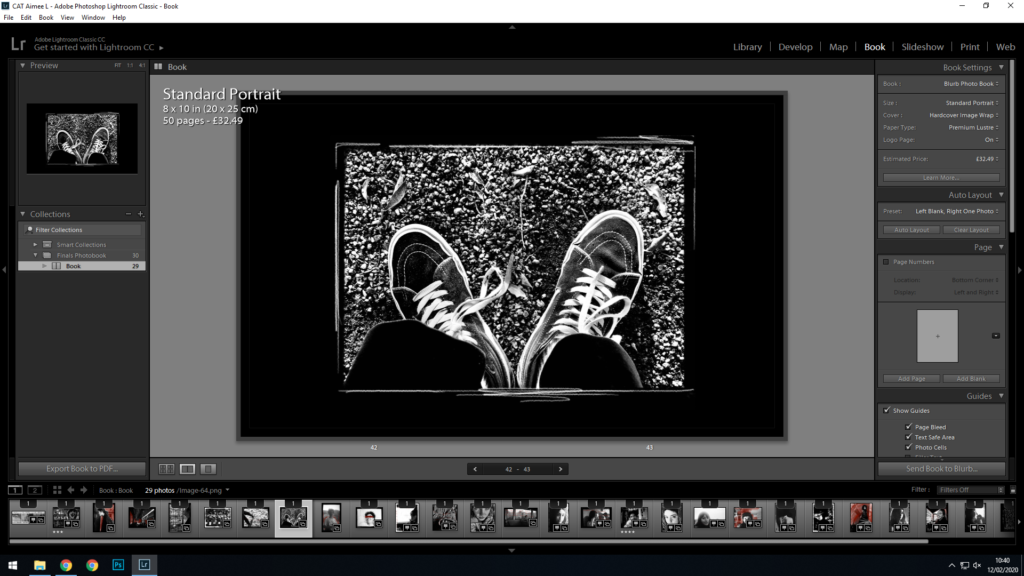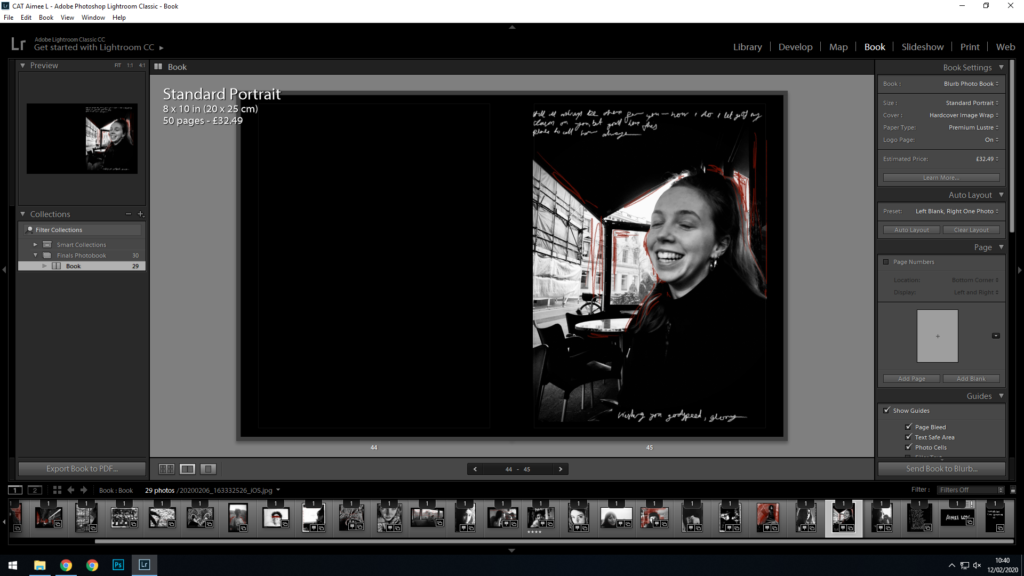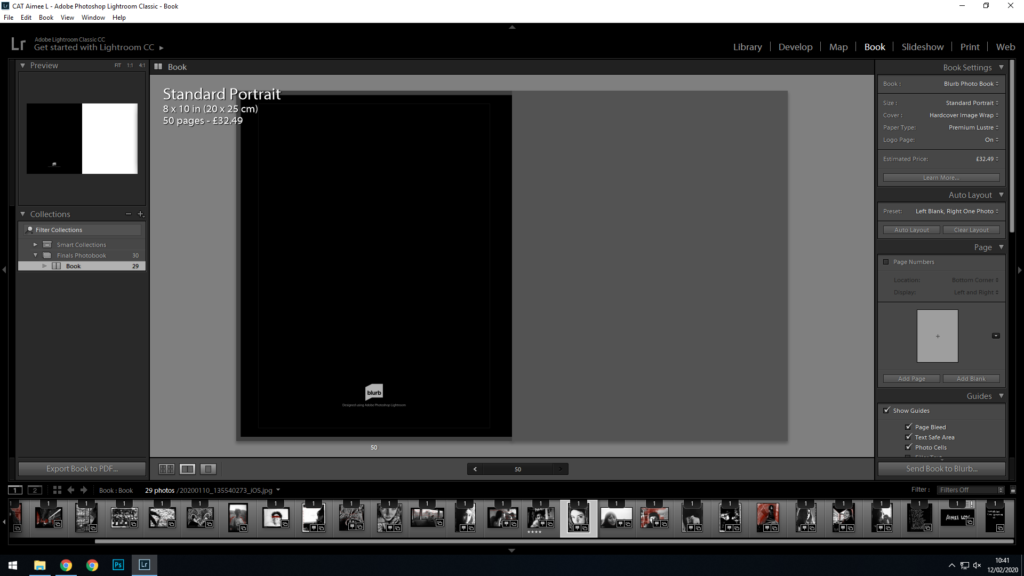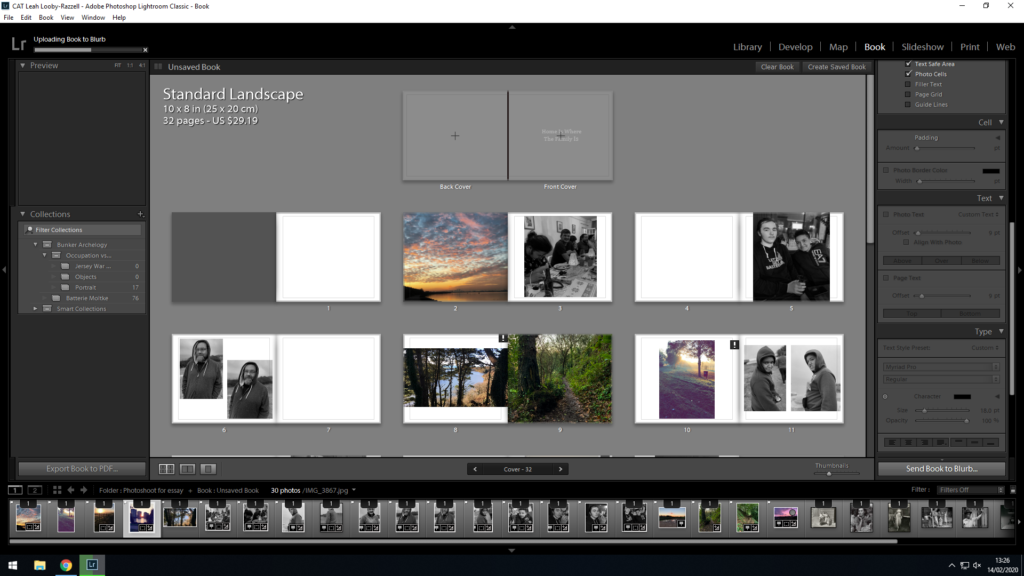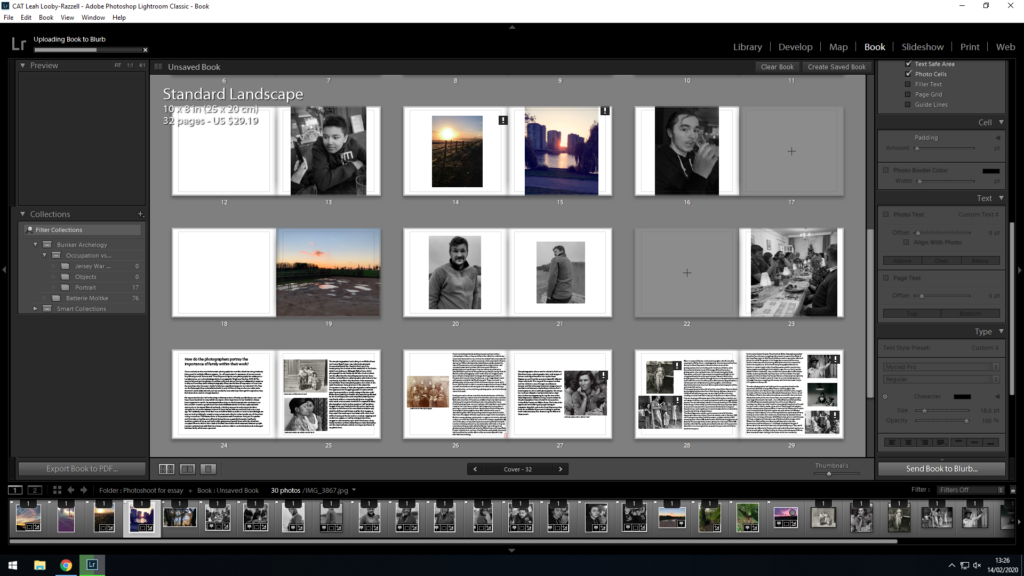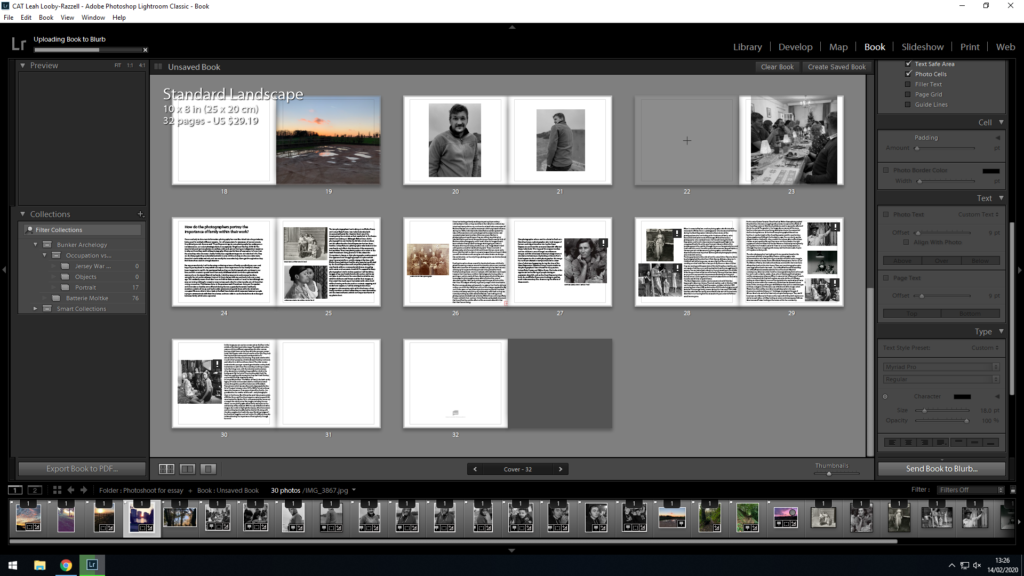This is the final layout of my photo book. I have made small changes in order to accommodate the amount of text i have placed in, but other than that there have been no major changes since the last blog post.

This is the final layout of my photo book. I have made small changes in order to accommodate the amount of text i have placed in, but other than that there have been no major changes since the last blog post.

This is the layout of my book once I have placed in my essay and all other text. I have chosen to dispurse my essay throughout my book, rather than putting the whole essay at the end.


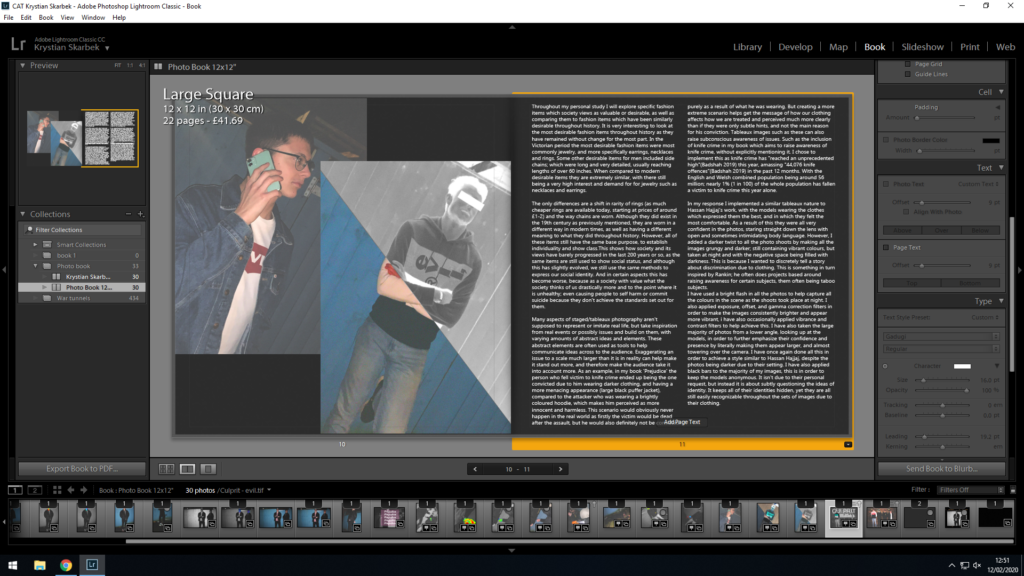

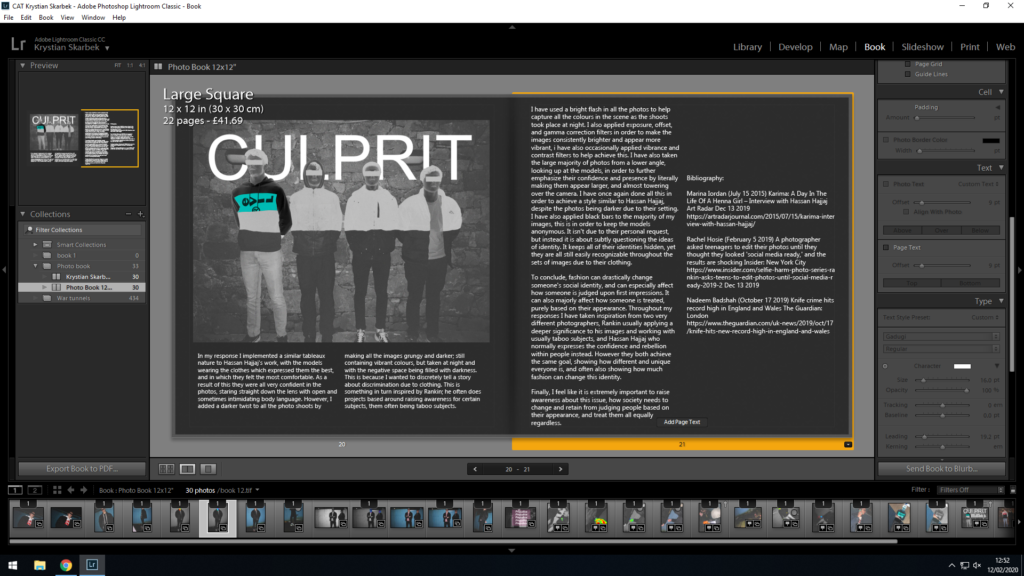
Final word count: 1,816
How do Diana Markosian and Rita Puig-Serra Costa express the notion of family history and relationships in their work?
“If manipulation is the first thing someone thinks of in connection to photography, what does that say about the value of the photograph as a reflection of reality?” (Bright and Van Erp 2019:17)
The notion of family is a subject that has been thoroughly explored by photographers such as Rita Puig-serra Costa and Diana Markosian. However, “when it comes to interpreting internal family dynamics, perspective is everything” (Hawarth,S. and Mclaney, S, 2016, 8). I believe each photographer portrays an either positive or negative view in regards to their personal relations, making it important to consider their individual point of view when deciding how much weight their narrative bears when showing the truth behind family dynamics. My personal study is focusing on my family’s history; more specifically the story of both my parents and important events in their life which lead to me being where I am today. I have chosen to analyse Markosian because her project “Inventing My Father” contrasts directly with Costa’s study “Where Mimosa Bloom” which I will also be referring to throughout this essay. I like the way Markosian explores the absence of her father in her life in such a personal and raw way, which eventually leads to a reunion which she captured through images. The photographs along with the context she provides into her life, makes this project very fascinating. Equally, I think the way Costa explores her family through the use of archival images and objects was effective as it really conveyed a sense of love and importance of family. I specifically loved how her entire project was an homage to her mother since carefully photographed objects paired with thoughtfully taken portraits further shows how fond she is of her family. These two photographers were particularly interesting to me as I felt I could personally relate to both bodies of work. Due to my Portuguese heritage, family is a of great importance to me and is valued highly in my family’s culture. However, my parents choosing to separate also led to the lack of a parental figure in my life which I will be exploring in the narrative. In this essay I will be discussing the notion of family and relationships, loss and hope in the works of both these artists, and evaluating my own response to their subjects.
Realism is the concept of capturing things in their natural element. This genre of photography is most useful when trying to capture something such as family history, as documentary photography allows us to be able to see someone’s real life situation through images. Photographers such as Dorothea Lange and Paul Strand focused on documenting the effects of urbanization and industrialization on working class Americans. This was something very prominent at the time of this movement, as the great depression in 1929 left a lot of people economically struggling. We now see this type of photography as realism. I feel as if this movement fits in well with my personal study as it recognizes the importance of capturing raw, documentary style images which I think is necessary when exploring something as personal as a family’s history, especially involving immigration and the struggle surrounding that journey. Images of this sort are characterized by having a wide depth of field and having sharp focus which contradicts the pictorialist style. The move away from creating a painterly aesthetic ultimately opened the door to a more forensic approach but also one that is open to distortion and manipulation in its pursuit of a good story of a good story. This will ultimately depend on the agenda of the artist, their integrity and skill in delivering a message, story or sequence of events.
In the words of Martin Parr, “most family albums are a form of propaganda, where the family looks perfect and everyone is smiling” (Hawarth, and Mclaney 2016, 7). Although to certain extent I believe this is true, Markosian goes against this idea as she uses a non-traditional method of exploring the family concept. Instead of portraying a sense of happiness and love, which is typically associated with family relationships, Markosian chooses a more raw and honest approach highlighting how she grew up without her father figure and turning that into the foundation that her project is built upon. In this context, I believe the words of John Tagg are appropriate as the view that “the camera is an instrument of evidence” (John Tagg:1988) perfectly demonstrates how Markosian’s work stands out amongst other artists exploring the same themes, since a certain truthfulness radiates from her images which goes against the dominating stereotype that every family is perfect, leading to a more contemporary output which appeals to modern day people.This view is put across quite skillfully and subtly through the use of black and white images which puts forward a sense of emptiness since the monochrome theme is often associated with despair. This means that the audience will be able to feel a certain coldness and the lack of emotion, while also simultaneously feeling a surge of emotion through the scenes and objects depicted in the images leading to an interesting contrast that is highly effective throughout her work. The use of archival imagery is complementary to Markosian’s photography since by itself it would usually portray a sense of happiness, however with the context, it is instead replaced with a slight sense of resentment, especially the archival image showing her dad cut out of an image.
I believe the image above to be one of Markosian’s best not just due to its impeccable technicality, but also because it is rich in context. This image shows a suitcase belonging to her father containing things such as undelivered letters, newspaper clippings, and a shirt he was saving for her brother’s wedding. This image is in black and white making it more emotionally detached yet since the objects are sentimental it creates an interesting juxtaposition, as it shows the photographer is conflicted over her feelings. I believe Diana Markosian represents a modern wave of photography where beauty can be found in imperfections, and appreciated.
“Where Mimosa Bloom” by Costa takes the completely opposite approach into the exploration of family culture. It becomes obvious that the entire project is very thoughtful and the audience can almost feel an overpowering sense of the love Costa has for her family. Although Costa focuses on the positiveness of relationships with family, I believe it is the underlying theme of her mother’s death which makes her work particularly stand out since it reinforces the view that “real families aren’t often idyllic” (Hawarth, and Mclaney, 2016, 7) , even though on the surface, her family circumstances appear favourable. While exploring important people, objects and places that play a significant role in her relationship with her mum, she alludes to her death in an ennobling way. This notion is put across carefully through many aspects throughout the book such as a light colour scheme which conveys a sense of delicacy through pastel shades and also the metaphorical link to mimosa, a tree that blooms bright, yellow flowers in Spring, in Barcelona, where Costa is from.
This image is one which perhaps evokes the most emotion. In this double page spread we see Costa clutching a premature bird in her hand. Costa said, “When she died, I felt like a bird whose mother had abandoned the nest. I had to learn how to fly on my own,”. The context in combination with the image depicts a real sense of vulnerability, conveyed through the bird, that Costa is feeling in relation to not having her mother anymore. I think that using the bird as a medium for her own feelings, further shows how much thought and care was taken into each image as this has deep metaphorical value. I think that Rita’s work is a more traditional way of portraying family as she utilises portraiture and archival objects in a positive way, while also showing feelings and emotions through metaphors. I believe Rita Puig-Serra’s work represents positive sentiments towards relationships giving an almost romantic representation of a typical family unit.This book exudes closeness and sentimentality, by showing a kind of poetic bond between her relatives. However, with the view that “photography is a system of visual editing” (John Szarkowski:1976), the possibility of work being refined and changed to reflect perfectionism could be high.
When capturing my own images, and throughout the editing process, I kept each photographer’s approach in mind. Below is a final outcomes of my personal study. You can see that by using Photoshop I was able to give the illusion that my mum was “cut out” of the image, and layered on top is an image showing medication used to manage her anxiety and depression. The aim of this picture is to show how my mother battled mental illness after my birth, while also representing the concept of family. This image contains elements from both Markosian and Costa’s work. The use of an archival image makes it very personal, expressing the sentiment of love, inspired by Costa’s work. However, the manipulation gives the image a certain degree truthfulness as it adds context about an emotionally difficult subject, and would otherwise may not have been obvious from the original image, similar to Markosian’s work.
To conclude, both Markosian and Costa have created very emotional pieces of work based on their own personal family stories and journeys. Although we do get a sense of love from Markosian’s work, I believe this sentiment is often fighting against a feeling of hatred and resentment towards her father, whereas we purely get the feeling of love and closeness from Costa’s photo book with hint of sadness due to the loss of her mother. Costa’s photo book contains a very unique color palette containing light, delicate, pastel colors which is expected as her images are delicately framed and excrete fondness towards her family. On the other hand, Markosian’s body of work contains a lot of black and white images which shows that there is a lot of distance between her and the subject, yet all the things she photographs are of rich sentimental meaning to her. Both photographers also make use of archival images and objects, Costa utilises this to show a deep connection to her mother whereas due to the nature of Markosian’s work, her archival objects are used to show her father as being someone she is detached from.
Bibliography:
Bright, S. and Van Erp, H.(2019). Photography Decoded. London: octopus Publishing House
Howarth, S. and McLaney, S. (2016). Family photography now. London: Thames & Hudson
Szarkowski, John (1976), William Eggleston’s Guide. New York & Cambridge, MA: The Museum of Modern Art & The MIT Press
Tagg, John (1988). The Burden of Representation. Basingstoke and New York: Palgrave Macmillan
Mary Ellen Mark was an american photojournalist. In 1975, Mark took photos on the set of ‘One Flew Over the Cuckoo’s Nest,’ where she met the women of Ward 81 for the first time. Along with friend and journalist, Karen Folger Jacobs, Mark spend 36 day on Ward 81 in Oregon State Hospital. In total 4,800 images were taken on 200 rolls of film.
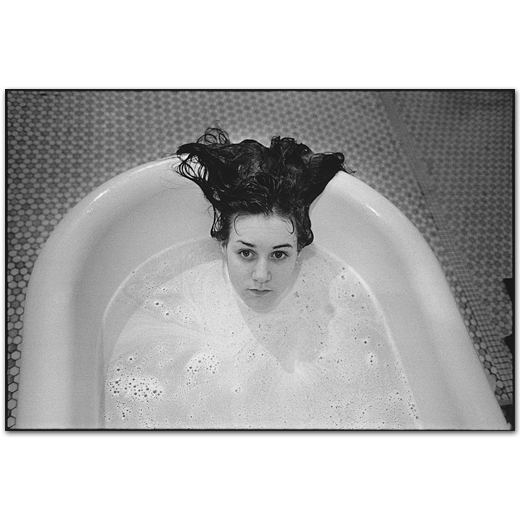
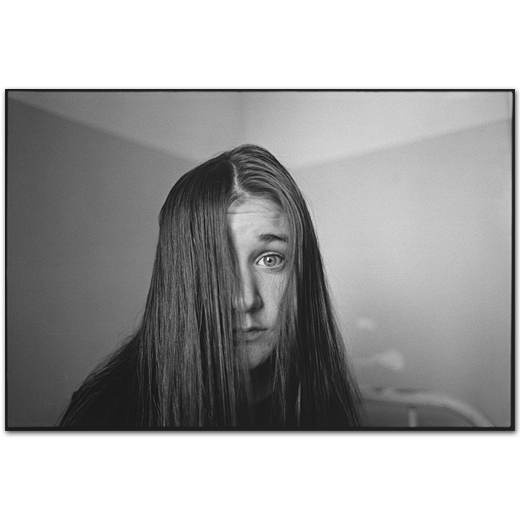
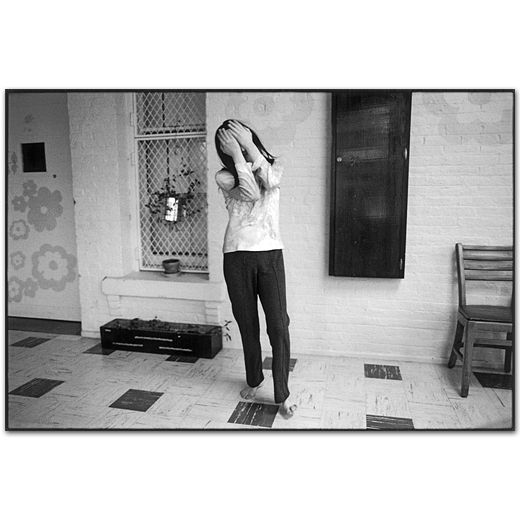
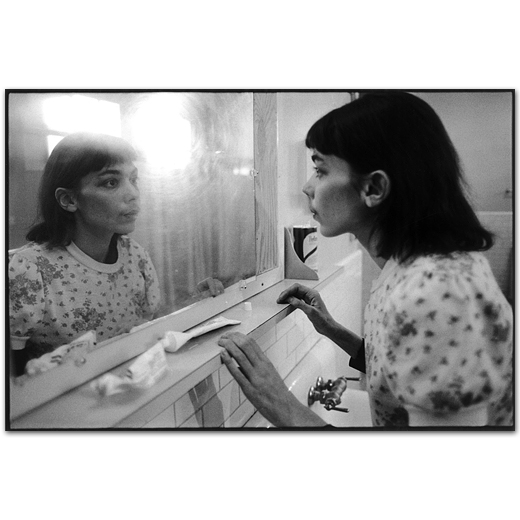

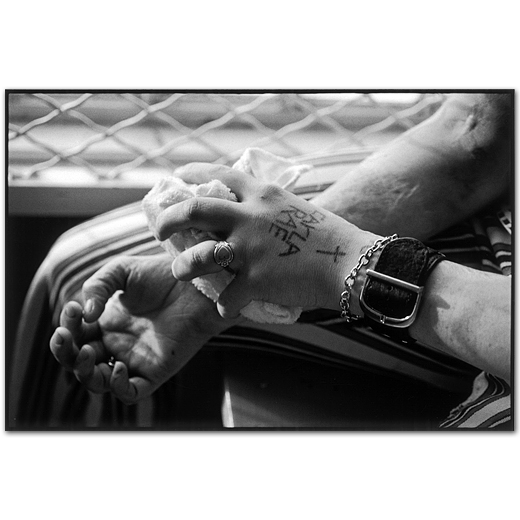
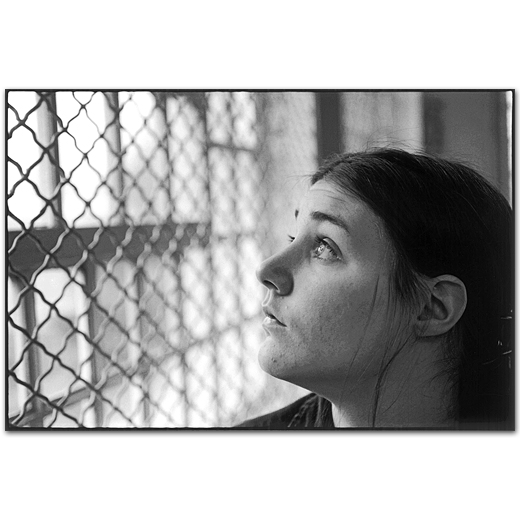
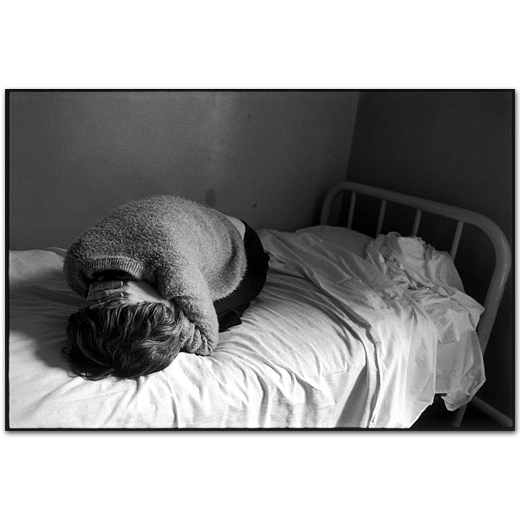
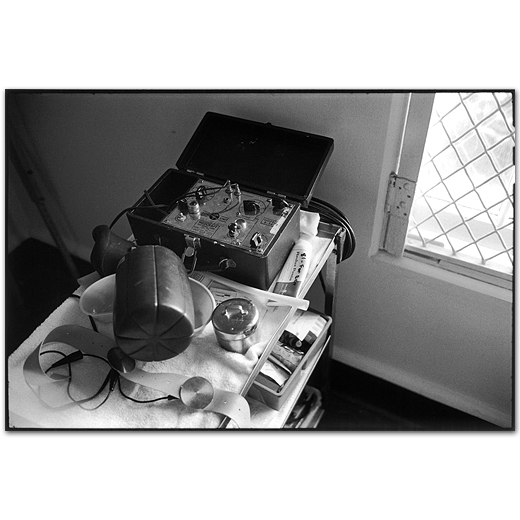

Some mental hospitals in the 1970s were still using electric shock therapy as form of treatment for mental illness. This aimed to relieve depressive symptoms for a short period of time. Folger Jacobs wrote about how a patient was given shock treatment after refusing to take her medication and succeeded in harming herself.
This image shows the required equipment for electric shock therapy on top of a table. The equipment is illuminated by light from a window on the right. The window is partially covered by wire arranged in diagonals.
The electric shock equipment demonstrates a treatment method commonly used on the ward. Folger Jacobs’ accompanying article suggests that treatment was given to patients regularly, however it was additionally administered if patients had a depressive episode. Other patients were not permitted and contact with fellow patients undergoing the treatment.
The wire covering the window on the right side of the images is likely to be a safety requirement to present patients from escaping the ward or attempting to harm themselves.
How it all started:
It all started when Talal’s Jordanian Grandfather Wael got his student visa and went to Bristol to study in college, while he was doing that he met Talal’s English grandmother Sherree in the same college and they fell in love, and had their first child later on which was Talal’s mother “Jumanah. After they had Jumanah, Wael’s student visa ran out so he had to go back to Jordan and left Sherree with two options which were either to stay in England and raise a child on her own or go live with him in a country she has never been to and barley knows anything about.
So Sherree being just young and in love chose option two and went to Jordan, where she discovered over the time that it’s not easy for an English women to live a normal western life in a middle eastern country, where women’s rights are different and what I like to refer to as “cultural clash” kicked in and created the differences between Sherree and Wael and these differences later on separated them when Jumanah was only 4 years old. So Sherree left and went back to her home country and Wael couldn’t raise a kid on his own so left Jumanah with her auntie and her auntie’s husband Muhammad Al-Jazi who raised her. So Talal always saw Muhammad as a Grandfather figure because he was practically the one who raised his mother.
Muhammad Al-Jazi and “the knife”
Muhammad (AKA: Abu Ali) was the kind of person who always lived his life on the edge as he was one of the most adventurous people in Talal’s life. So one day he invited Talal to go with him to his small hunting house which was located in Ma’an in Jordan, and that was one of the most traditional places in Jordan with only a few houses and a lot of desert land so they went Jar-boa hunting in the morning then went back to his summer house for lunch and that’s where Talal being his touchy self-wanting to touch and play with anything he can get his hands on, picked up an outstanding antique knife Abu Ali had in the middle of his desk on a fancy stand, out of curiosity Talal opened the case of the knife and while he was doing that Abu Ali just realized what he was doing so screamed: “NO! Talal!” So Talal got jump scared and dropped the knife on the floor where the lion head on the end of the knife broke into three pieces as it was some type of ceramic. So he looked at Talal and said that this was a really precious thing to him so Talal asked him why was it? and he replied by telling Talal to take it with him back home and to fix it, so he can give it back to Abu Ali as it was before, in order for him to tell Talal the story behind it.
The terrible death of Abu Ali
As they were heading back home to the city Amman they went to see a buggy shop on the way as Abu Ali was curious to see the new buggies they got, so they went inside and as Abu Ali was looking around he found a nice dirt ATV and hopped on it to ask Talal how he looked on it, and he replied by informing him how much it suits him, so he bought it on the spot and they told him that they will deliver it to his farm house next day. So Talal went back home and everything was fine until he woke up next day to the noise of crying coming from his parents room, so Talal instantly thought that his great grandmother passes away because she was very poorly with cancer at that time so it just felt normal to him so he just started crying then his dad came into his room with his eyes all filled up with tears then he asked Talal why was he crying and he told him: “did my great grandma pass away?” And he replied: “no son she’s still fine but a couple of hours ago in the morning your grandpa Abu Ali got an ATV delivered to his farm so he got too excited and took it right away for a test drive, then went on a dirt path at the top of a mountain where he was going down the path and went straight into the valley where two farmers found his body beaten like a rag doll and called the ambulance so a helicopter came and took him right away where he passed away mid-way to the hospital on the helicopter”. And Talal just had the weirdest feeling as he knew it was true but just couldn’t believe it in the same time because his head just didn’t process the information because he was just with him the day before when he was in perfect health.
The story behind the knife
After being in shock behind the story Talal heard he started to process that his grandfather actually passed away a couple of days after the incident. So on the third day of the funeral Talal was with Hamza which is Abu Ali’s eldest son and Talal asked him: “what should I do with the knife because I was supposed to give it back to him after fixing it.” So Hamza was really surprised when he showed him the knife and Hamza said: “that’s a really antique and priceless knife you have there.”, then Talal asked him if he knew the story behind it and he told him all about it.
What Talal learnt about his family history.
After Hamza told Talal about the story behind the knife Talal was left in shock after Hamza informed him that this knife belonged to his great grandfather Mashhour Al-Jazi, who was the command officer of a really important battle in Jordan, which was between Israel and Jordan and Palestine’s combined force. The war was called “Battle of Karameh”. And the knife Talal has was actually the knife Mashhour used in that battle. Mashhour is a really loved and known figure by his country as he did great things for it.
How Mashhour’s accomplishments Inspired Talal
After Talal learnt all about Mashhour’s stories he got really inspired by the world of War and national service, then kept doing all his research about it. And his dream ever since was to join the Jordanian Military service. But unfortunately due to family reasons a couple of years after that Talal had to move away from his family alone to live with his friend in Jersey. But being his stubborn self he didn’t change his mind about joining the national service and still worked with what he had even if it cost him serving a country he wasn’t brought up in. So he joined the Marine Cadets at the beginning where he was exposed to the experience soldiers go through in the Navy, to give him a kind of sense of what he was getting himself into.
Everything was going great for Talal apart from the racism he received at the cadet center due to his different ethnicity which confused him about whether he wants to go through that in the actually navy, because it’s a lot of years of commitment and there’s no going back.
Here you will see my final prints, which I plan on mounting on foam board. I wanted to mount on foam board -instead of cutting a window mount for example- because my personal study is essentially a story. This means a foam board will be more suitable because it allows greater flow, and is not as strict and put in place as a window mount. Each image is going to represent a different point in the narrative, which I will explain below.

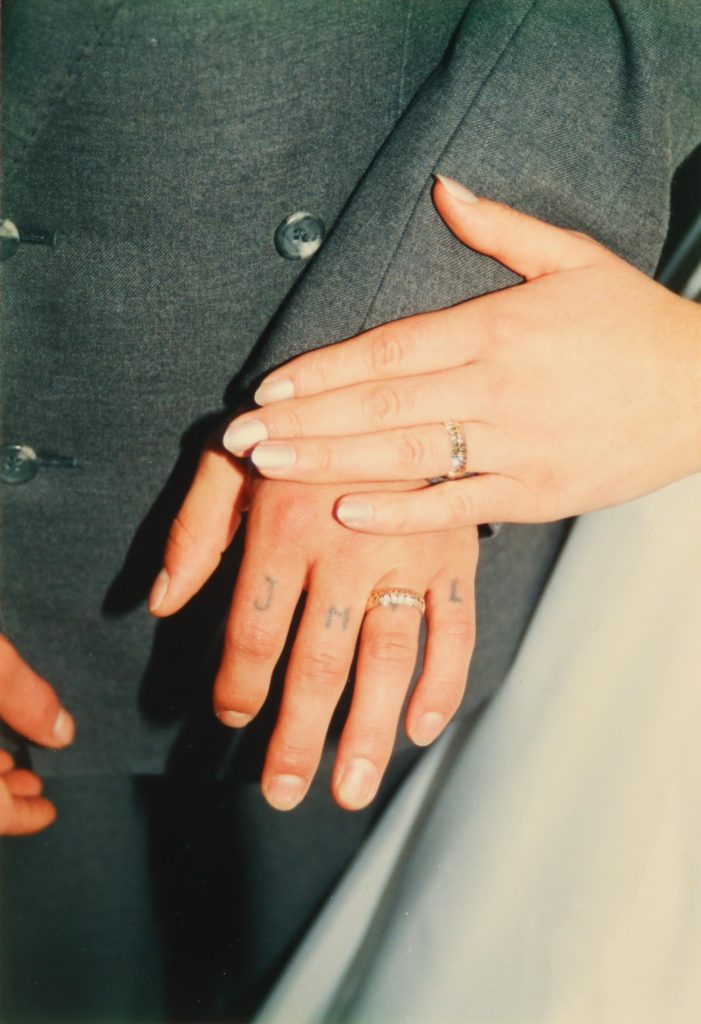




Below are the selection of images I will be printing and mounting:


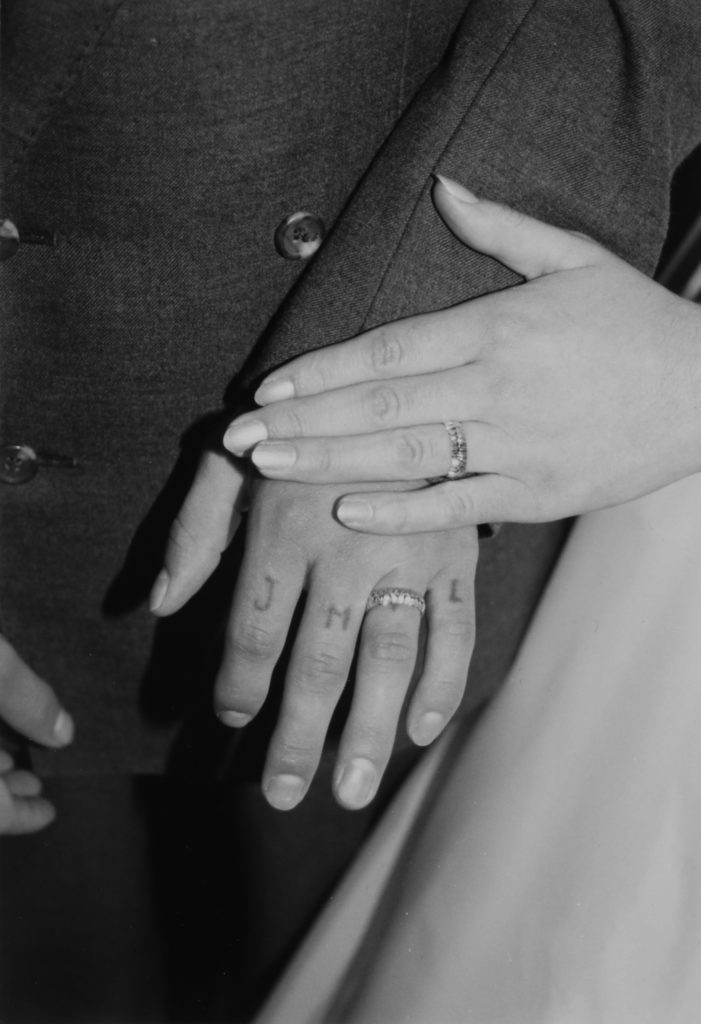
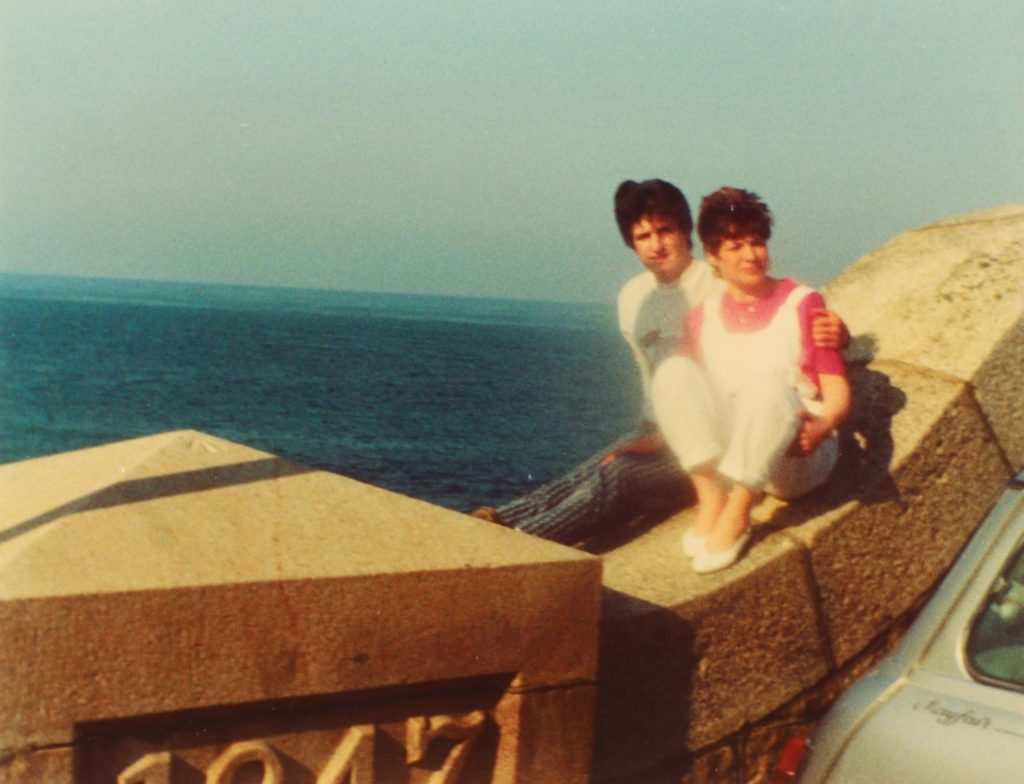
what my final piece will look like:

Actual final piece:

How does fashion shape social identities?
“Once you have a person in front of you that oozes this kind of energy, by dressing them up or allowing them to wear their own styles, the strength of their personality instantly comes out.” (Iordan 2015)
As Hassan Hajjaj says in the above quote, people’s styles and clothing play a substantial part in expressing their personality. And if you allow them to wear what they’re comfortable in their personality does instantly shine through. This also plays a large role in social identity; the way we dress affects both how we view ourselves, as well as how others view us, and possibly judge us on the way we dress. In this personal project I will focus on exploring social identity and how it is shown/expressed through fashion. I will do this mainly through portrait photography and more specifically full body shots; implementing the style of Hassan Hajjaj into my work. I will do this by trying to capture the subject’s personality and strengths through their style and body language, I will also implement the same contrasting bold colours into my work. I will also try break fashion stereotypes such as in Hassan Hajjaj’s ‘Kesh Angels’ portrait series where he photographs the Kesh Angles biker group who wear Hijabs and ride around the city, in most places in the area this is either looked down upon or illegal. I will also try implement close-up portraiture into this project, in the style of Rankin who heavily focuses on face and top 1/3 portraits. Rankin focuses a considerable amount on social identity throughout his work which I will take inspiration from in my project. This includes projects such as “Selfie Harm” (Hosie 2019) project; where Rankin took portraits of teens and gave them 15 minutes to edit their portraits to a ‘social media ready’ standard. I will also possibly include elements of tableaux photography in my project, I will try use this to help exaggerate the above mentioned themes through acting, in hopes of achieving an image which shows exaggerated levels of confidence, or the lack of it. I will use this to show the contrast of how fashion can affect us mentally.
Throughout my personal study I will explore specific fashion items which society views as valuable or desirable, as well as comparing them to fashion items which have been similarly desirable throughout history. It is very interesting to look at the most desirable fashion items throughout history as they have remained without change for the most part. In the Victorian period the most desirable fashion items were most commonly jewelry, and more specifically earrings, necklaces and rings. Some other desirable items for men included side chains; which were long and very detailed, usually reaching lengths of over 60 inches. When compared to modern desirable items they are extremely similar, with there still being a very high interest and demand for for jewelry such as necklaces and earrings. The only differences are a shift in rarity of rings (as much cheaper rings are available today, starting at prices of around £1-2) and the way chains are worn. Although they did exist in the 19th century as previously mentioned, they are worn in a different way in modern times, as well as having a different meaning to what they did throughout history. However, all of these items still have the same base purpose, to establish individuality and show class. This shows how society and its views have barely progressed in the last 200 years or so, as the same items are still used to show social status, and although this has slightly evolved, we still use the same methods to express our social identity. And in certain aspects this has become worse, because as a society with value what the society thinks of us drastically more and to the point where it is unhealthy; even causing people to self harm or commit suicide because they don’t achieve the standards set out for them.

Many aspects of staged/tableaux photography aren’t supposed to represent or imitate real life, but take inspiration from real events or possibly issues and build on them, with varying amounts of abstract ideas and elements. These abstract elements are often used as tools to help communicate ideas across to the audience. Exaggerating an issue to a scale much larger than it is in reality can help make it stand out more, and therefore make the audience take it into account more. As an example, in my book ‘Prejudice’ the person who fell victim to knife crime ended up being the one convicted due to him wearing darker clothing, and having a more menacing appearance (large black puffer jacket), compared to the attacker who was wearing a brightly coloured hoodie, which makes him perceived as more innocent and harmless. This scenario would obviously never happen in the real world as firstly the victim would be dead after the assault, but he would also definitely not be convicted purely as a result of what he was wearing. But creating a more extreme scenario helps get the message of how our clothing affects how we are treated and perceived much more clearly than if they were only subtle hints, and not the main reason for his conviction. Tableaux images such as these can also raise subconscious awareness of issues. Such as the inclusion of knife crime in my book which aims to raise awareness of knife crime, without explicitly mentioning it. I chose to implement this as knife crime has “reached an unprecedented high”(Badshah 2019) this year, amassing “44,076 knife offences”(Badshah 2019) in the past 12 months. With the English and Welsh combined population being around 56 million; nearly 1% (1 in 100) of the whole population has fallen a victim to knife crime this year alone.
In my response I implemented a similar tableaux nature to Hassan Hajjaj’s work, with the models wearing the clothes which expressed them the best, and in which they felt the most comfortable. As a result of this they were all very confident in the photos, staring straight down the lens with open and sometimes intimidating body language. However, I added a darker twist to all the photo shoots by making all the images grungy and darker; still containing vibrant colours, but taken at night and with the negative space being filled with darkness. This is because I wanted to discretely tell a story about discrimination due to clothing. This is something in turn inspired by Rankin; he often does projects based around raising awareness for certain subjects, them often being taboo subjects.
I have used a bright flash in all the photos to help capture all the colours in the scene as the shoots took place at night. I also applied exposure, offset, and gamma correction filters in order to make the images consistently brighter and appear more vibrant, i have also occasionally applied vibrance and contrast filters to help achieve this. I have also taken the large majority of photos from a lower angle, looking up at the models, in order to further emphasize their confidence and presence by literally making them appear larger, and almost towering over the camera. I have once again done all this in order to achieve a style similar to Hassan Hajjaj, despite the photos being darker due to their setting. I have also applied black bars to the majority of my images, this is in order to keep the models anonymous. It isn’t due to their personal request, but instead it is about subtly questioning the ideas of identity. It keeps all of their identities hidden, yet they are all still easily recognizable throughout the sets of images due to their clothing.


I have used the previously mentioned style for exactly half of my book ‘Prejudice’. For the second half of the book I wanted to create a story with my responses, and I have produced images which resemble CCTV footage with heat mapping. It is the story of discrimination and prejudice due to clothing and appearance which I have previously mentioned. The elements of the images with a heat map filter applied are the focal points of the images, with the heat mapping diverting the viewer’s attention to them. The heat mapping also varies from warm tones (red, yellow, green) to cold tones (blue, navy, purple). This is done to signify the shift of the people in the photos becoming cold, heartless, inside. a subtle hint to how knife crime can change a person.
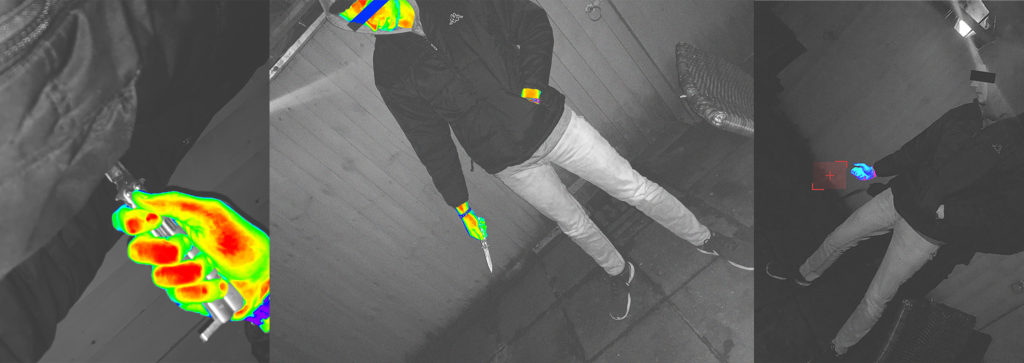
To conclude, fashion can drastically change someone’s social identity, and can especially affect how someone is judged upon first impressions. It can also majorly affect how someone is treated, purely based on their appearance. Throughout my responses I have taken inspiration from two very different photographers, Rankin usually applying a deeper significance to his images and working with usually taboo subjects, and Hassan Hajjaj who normally expresses the confidence and rebellion within people instead. However they both achieve the same goal, showing how different and unique everyone is, and often also showing how much fashion can change this identity.
Finally, I feel like it is extremely important to raise awareness about this issue, how society needs to change and retain from judging people based on their appearance, and treat them all equally regardless.
Bibliography:
Marina Iordan (July 15 2015) Karima: A Day In The Life Of A Henna Girl – Interview with Hassan Hajjaj Art Radar Dec 13 2019 https://artradarjournal.com/2015/07/15/karima-interview-with-hassan-hajjaj/
Rachel Hosie (February 5 2019) A photographer asked teenagers to edit their photos until they thought they looked ‘social media ready,’ and the results are shocking Insider: New York City https://www.insider.com/selfie-harm-photo-series-rankin-asks-teens-to-edit-photos-until-social-media-ready-2019-2 Dec 13 2019
Nadeem Badshah (October 17 2019) Knife crime hits record high in England and Wales The Guardian: London https://www.theguardian.com/uk-news/2019/oct/17/knife-hits-new-record-high-in-england-and-wales
Below is my finished photo-book made using Blurb through Lightroom. It comprises of 50 pages, with a hardcover front. I don’t look like the look of an image wrap and I couldn’t find a text font which matched the handwriting style which I wanted. Therefore like most of the images inside, I created the title by hand with my own handwriting and then using Photoshop I added it onto my front cover and my name on the back.
https://www.blurb.co.uk/b/9950618-nothing-can-come-between-us
